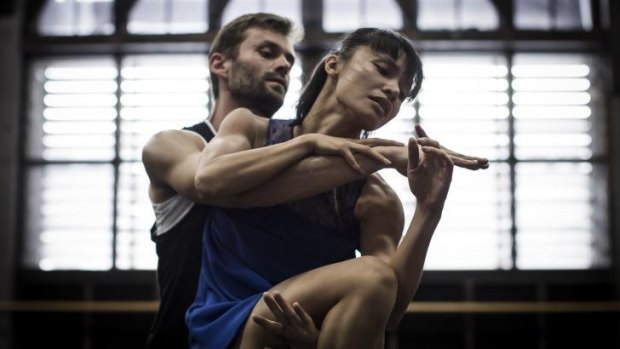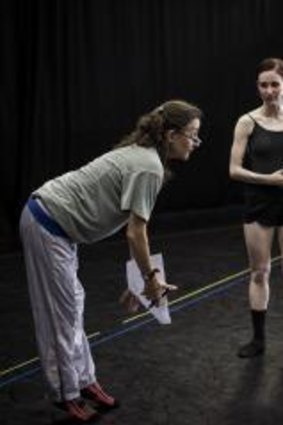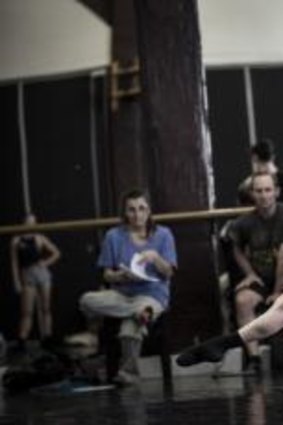This was published 8 years ago
Dancing on the edge: the Sydney Dance Company's daring new work
Risk-taking and loss are at the heart of the Sydney Dance Company's latest production, Quintett. Created by groundbreaking choreographer William Forsythe in 1993 for his terminally ill wife, the work sets tradition on its head and demands that dancers journey to the edge.
Former dancer and Forsythe collaborator Ana Catalina Roman Horcajo, who came to Australia to restage the work, says that part of her task was to convey the idea of risk. The dancers' biggest challenge, she says, is taking responsibility for the material. "There comes a point where it is you who decides. It will never be the same thing twice; find the opportunity. If something does not go exactly how you plan it, take it from there."

Bernhard Knauer and Charmene Yap during rehearsals for Quintett.Credit: Peter Grieg
Forsythe's wife, Tracy Kai-Maier, was gravely ill with cancer when Quintett was being created and she died in 1994. She never saw it performed.
When the SDC's artistic director, Rafael Bonachela, saw Quintett staged in London by Forsythe's Ballett Frankfurt in the late 1990s, he was blown away. "It was so human and so moving and everything I aspired to feel about dance in every way," he recalls. It influenced his desire to become a choreographer, and he has long hoped that the company would have the chance to perform it. "I knew that we would do this work justice in every way I could possibly imagine. I knew the dancers would approach it with the bravery, the fearlessness, the attack that you need."

Quintett rehearsal, with (from left) Ana Catalina Roman Horcajo, Jesse Scales, Thomas McManus and Cass Mortimer Eipper.Credit: Peter Grieg
Quintett is part of a double bill, Frame Of Mind, that the SDC is bringing to Melbourne in May. It is a work of simplicity and daring, emotion and invention, a haunting, memorable piece by one of the most innovative and accomplished of contemporary choreographers. It is being performed for the first time in Australia.
Horcajo, a long-time member of Ballett Frankfurt, which first performed the work, oversaw the restaging alongside Thomas McManus, one of the five original dancers. As is Forsythe's wont, those five dancers are credited as co-choreographers.
Forsythe has said that when it comes to restaging, what is important is not the ballet, but the performance: it's more about discovery than dutiful representation. For Horcajo, the task for the dancers is "to keep the piece authentic and real and true to the origins, and at the same time make it their own, in the present". "It's like a mesh, like fabric, you have to weave it all together."
She knows that it is a big deal for any company to undertake a Forsythe work. She and McManus gave classes – including improvisation classes – as part of the preparation. They oversaw the selection of two casts of five, plus dancers to cover unforeseen eventualities, but everyone in the company of 17 had the chance to learn the techniques and become acquainted with the work.

Jesse Scales and Sam Young-Wright in rehearsals for Quintett.Credit: Peter Greig
For SDC members Jes
Scales and Yap are dancing the role known as "the girl in blue", the part that Horcajo also took during almost 20 years in Ballett Frankfurt. But "she was very happy for us to find our own way, which was really lovely", Scales says.
Forsythe's choreography is strongly based in classical technique, but he pushes it in disconcerting directions. "One of the characteristics of Bill's work is that he likes to challenge gravity, he likes the off-balance," Horcajo says. "He's much more happy if you risk something that surprises you in the outcome."
Yap describes this aspect as "controlled abandonment", pushing yourself almost to a point of no return, then recovering. "That's what you strive for, because there's a lot of risk-taking in the whole work."
It's a combination of the precarious and the precise, of a control that seems lost, then is effortlessly regained. "You find the point where you can save it at the very last second," says Scales.
There are five distinct characters in the work, but nothing obviously resembling a narrative. Horcajo likes to emphasise the fact that the meaning is in the movement; for Forsythe, she says, the ideas are contained within the steps. "Sure, for him in his head, there are concepts, but for most of them, even if there are emotional concepts, he translated them into movement."
At the same time, there is space for the dancers' intervention, with flexibility built into Quintett – the capacity for improvisation within particular phrases.
The music is a potent, memorable element. Written by British composer Gavin Bryars, Jesus' Blood Never Failed Me Yet is a composition of deceptive, almost unsettling simplicity, of repetition and slight variation that has a hypnotic quality. Bryars uses the voice of an elderly homeless man recorded in 1971 for a documentary film, singing a verse from an unknown song of faith. Bryars looped it, and created an orchestral accompaniment, a gradually swelling counterpoint.
Music and movement are in "an ongoing roll", says Yap. To Scales, "it builds ever so slightly, which is really interesting, enough for you to realise that it's building, but not enough to overwhelm you; it is quite hypnotic. You can say, I'm going to hear the guitar a bit more and match steps to that, or I'm going to hear the voice a bit more in these parts. You can pick and choose different things, which is really cool."
Another feature of the work is a sense of belonging. "It's an entity, five people and their own community, a world in itself," says Yap.
In the final run-through before opening night, Horcajo calls the dancers together for a group hug. "They call it the circle of love," she says. She tells them to listen to each other, and to have fun with the piece "because it is a joy to do". Quintett is not simply a dance work, it is also a conversation, an expression of the relationship between five people, she says. And it's a work that never stays in one place. If there is one thing she wants to emphasise from her own experience, it's this: "I always put myself in the mindset where I perform it as if I have never performed it before. As if every time, I am dancing it for the first time."
Philippa Hawker travelled to Sydney as a guest of the Sydney Dance Company. Frame Of Mind is at Canberra Theatre Centre from April 30 to May 2 and at Southbank Theatre, Melbourne, from May 6 to 16.